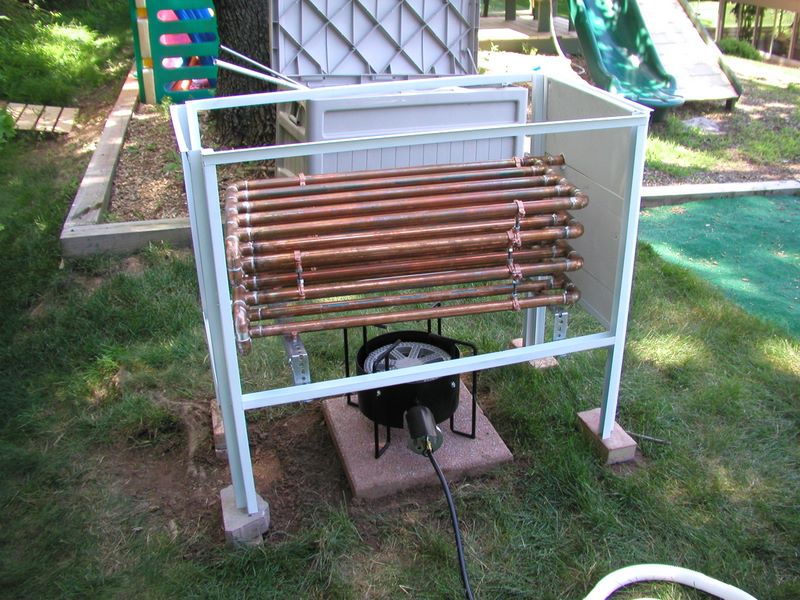First |
Previous Picture |
Next Picture |
Last

Stephen Miller accepts correspondents about his design at drsbmiller@verizon.net
From: Stephen
To: Todd Harrison
Todd -
It seems you have garnered quite a following, including me.
Attached is my version of the "redneck pool heater", borrowing freely from the many great ideas I observed on your site and links thereto. My key design changes:
1) I had a lightweight frame built to support the heat exchanger and I encased the heat exchanger with refractory panels that I was able to secure from my business. These work very well to contain the heat without a lot heat lost to radiation.
2) To reduce the pressure drop, slow the flow and increase the internal volume, I built the heat exchanger out of 1" copper pipe and fittings. This design results in about 75 feet of 1" tubing, or a little more than 3 gallons of water volume inside the heat exchanger. The pool filter pump pushes water through this heat exchanger very easily, so easily, in fact, I have to throttle the flow a little to get a higher temperature increase. I haven't worked out the math on this (maybe some of your engineer-readers will know right away) - is faster flow / lower temperature rise better than slower flow / higher temperature rise?
3) Performance wise, it works OK. At full pump flow (which I don't know since I can't measure it), 65F water entering the heat exchanger exits at about 85F. At somewhat reduced flow, more like 100F; this is my normal operating mode. I can warm the pool from, say, 68F up to 82F in 4-5 hours. At greatly reduced flow, I have measured outlet temperatures exceeding 125F. This design would definitely benefit from a second burner to enable heating the pool at a faster rate.
4) One of the big problems with my design - cost. Although it was a lot of fun to build, these days, 1" copper tubing and fittings are not cheap at your local Home Depot. In addition, I go through a bunch of propane. The system will consume a 20 lb propane cylinder in just a few hours, and the going price for propane is about $15 per fill. Then again, what price are we all willing to pay to stop the little cherubs from complaining - apparently a lot, because we all went to a lot of trouble to build these.
Stephen B. Miller
----reply----
From: Todd Harrison
To: Stephen
Stephen,
WOW! This is great! You really did learn from the older attempts by me and others. Great job!
I would say that faster flow is always better being the greater the temp delta the easier heat will transfer. You could test this simply by heating your pool both ways. Keep records and report back. I will post your results.
You can see your page under "More Photos" on the http://www.redneckpoolheater.com site.
Thanks for the photos and please keep me updated and I will post your updates to your page.
Stay safe: Never let kids play around the heater when it's being used to heat the pool. Make sure the gas if off when no water is flowing.
Tip: I notice that the tanks freeze up some when running so what you can do is get one of those big tubs with handles and strap the tank in the middle. Fill the tub with water. The water in the tub around the tank will keep it from freezing up. You can replace the water in the tub if it stats to freeze up. You will get every last oz of propane out of your tank and the burners will run at full pressure and higher flames helping heat your pool faster being the propane will not be getting so cold. When propane gets too cold it will stay a liquid even when not under pressure which makes your flames die down to nothing or blow out.
----reply----
From: Stephen
To: Todd Harrison
Todd
Yes, your tip is correct. I do have a large tub, and I do have to submerge the propane tank in water to prevent ice formation (I use the warm water from the outlet of the heater itself, and it needs to be changed out at least once during a run). For you scientists out there, this effect is called Joule-Thompson cooling - heat is required (the heat of vaporization) to convert the liquefied propane to gas, and this is all happening fast when using the Cajun burner. I have actually had a block of ice more than inch thick on the bottom of a tank.
Thanks very much for posting my heater on your site.
Dr. Stephen B. Miller